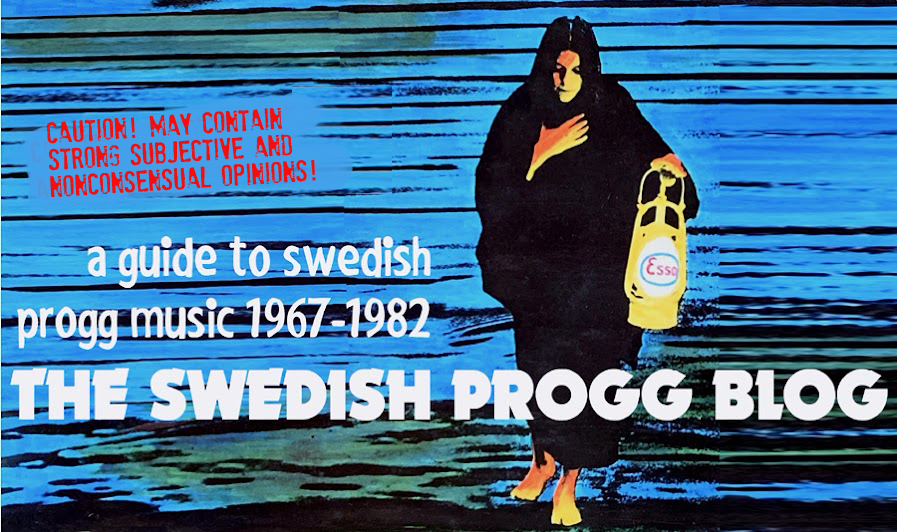Swedish vocals
International relevance: **
Ranked #20 on the blog's Top 25 list
Quite possibly the most peculiar progg
album ever released, Philemon Arthur & The Dung's first (and for
a long time, only) album still sounds as hilarious and bewildering as
upon its original release in 1971. Philemon Arthur & The Dung
caused an outrage when they won the Swedish Album of the year Grammy
in 1972. So indignant was the music business establishment that no
further national Grammy Awards ceremony were held until 1988. To add
insult to the injury – at least as far as some people were
concerned – Philemon Arthur & The Dung didn't even appear at
the ceremony to collect their award. Instead, a reel-to-reel recorder
was rolled onto stage, on which tracks from their self-titled album
was played.
Thing is, there was no group. Or should
I say, there were no group members known to anyone but a handful of
people, including the staff of Silence Records and the members of
Träd, Gräs & Stenar who had performed a cover version of
Philemon Arthur's ”In kommer Gösta” at the Gärdet festival a
year before Philemon Arthur themselves struck the unexptecting
audience by baffled surprise.
The true identity of Philemon Arthur & The Dung remained a secret for decades, causing wild speculations as to who they really were. One of the most popular theories insisted that the name was a pseudonym for the Wiehe brothers Mikael (of highly successful Hoola Bandoola Band) and Thomas (with a a series of underappreciated solo albums under his belt). The idea was that the Wiehes had recorded the music while they were still kids. However, both have repeatedly denied it emphatically over the years. (Those who want a portrait of the artists as slightly younger men may want to check out the Moccers compilation released in 2004 – Moccers were a late 60's band featuring both brothers.) Others have suggested that Philemon Arthur & The Dung were in fact Risken Finns who released two albums in the 70's, while others in turn have named popular singer Dan Hylander as responsible for the eccentric, homemade recordings that caused the Grammy upheaval.
The true identity of Philemon Arthur & The Dung remained a secret for decades, causing wild speculations as to who they really were. One of the most popular theories insisted that the name was a pseudonym for the Wiehe brothers Mikael (of highly successful Hoola Bandoola Band) and Thomas (with a a series of underappreciated solo albums under his belt). The idea was that the Wiehes had recorded the music while they were still kids. However, both have repeatedly denied it emphatically over the years. (Those who want a portrait of the artists as slightly younger men may want to check out the Moccers compilation released in 2004 – Moccers were a late 60's band featuring both brothers.) Others have suggested that Philemon Arthur & The Dung were in fact Risken Finns who released two albums in the 70's, while others in turn have named popular singer Dan Hylander as responsible for the eccentric, homemade recordings that caused the Grammy upheaval.
None of those assertions are, in fact,
far-fetched as all suggested artists hail from the Skåne region in
the south of Sweden, thereby speaking in a highly distinguishable
Skåne dialect similar to the one heard on Philemon Arthur's album.
However, Träd, Gräs & Stenar gave away a clue to the origins of
the mysterious duo already with their Gärdet performance of "In kommer Gösta", when
TG&S frontman Bo Anders Persson mentioned they got the song from
someone in the small town of Torekov in the northwest part of Skåne.
(Hylander and the Wiehe brothers are from Malmö, Risken Finns were
from Lund.) In recent years, Philemon Arthur & The Dung have been
identified as brothers Mats (today a school teacher) and Stellan
Larsson from – you guessed it – Torekov.
Needless to say, the mystery
surrounding them added to the public interest in Philemon Arthur &
The Dung, but the truth is that even though the highly plausible
identity of the band members has been revealed, the music they made
has lost none of its quirky and bizarre appeal. Like many have done
over the years, one could dismiss it as the ridiculous rantings of
two kids in their mother's attic, and yes – ”Philemon Arthur &
The Dung” is childish and silly and
nonsensical, but the nonsense is incredibly uplifting, and the
relentless banging of cookie jars instead of drums, the insane vocals
and the unhinged hammering on guitars are all exhilarating and
utterly exciting.
But more important, the songs are in
fact good and irresistably melodic. The absurdist lyrics have serious
strains, such as the eerie, post-apocalyptic ”Den sista veckan”
(”the last week”), and ”Ingenting i din hjärna” (”nothing
in your brain”) and ”Naturen” (”the nature”), both funny
and cynical takes on the modern day consumerist society. Although
entirely sung in Swedish, the uninhibited craziness of ”Philemon
Arthur & The Dung” reaches far beyond any language barriers and
reminds me of ”White Light/White Heat” by The Velvet Underground,
albeit entirely free of distorted guitars. At least entirely free of
distorted electric guitars.
A truly original act, Philemon Arthur &
The Dung have inspired many Swedish bands over the years, including
long running genre defying avant/dada band Dom Dummaste who covered "Men va fanken". Decidedly unpretentious and
without the slightest ambitions to impress people, ”Philemon Arthur
& The Dung” is a marvellous effort and an obvious inclusion on
this blog's Top 25 list of progg albums.
Musikens historia del I & II full album playlist


philemonial!
ReplyDeleteHaha! :-D
ReplyDelete